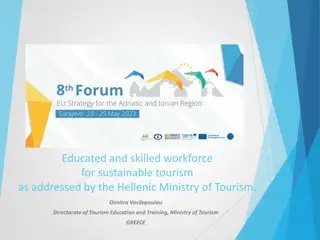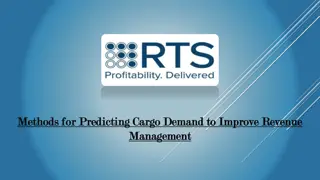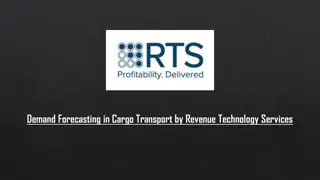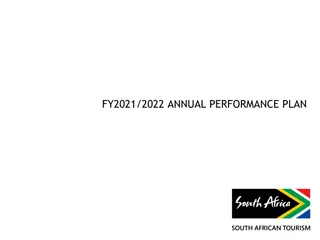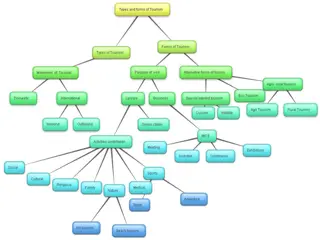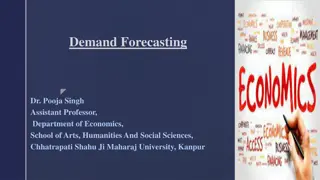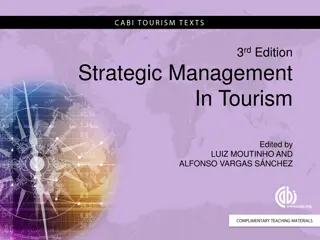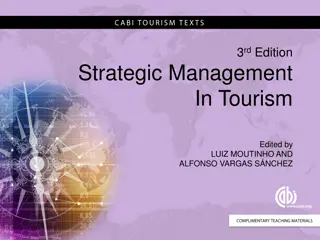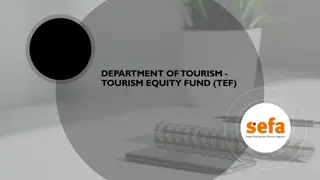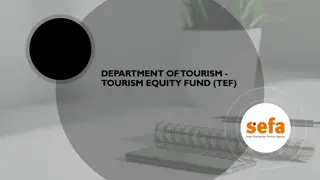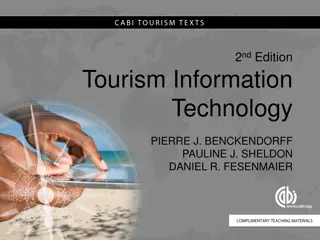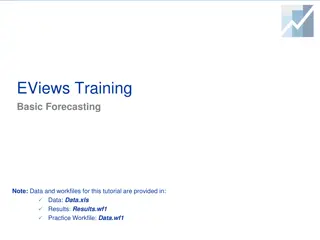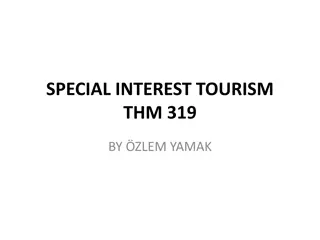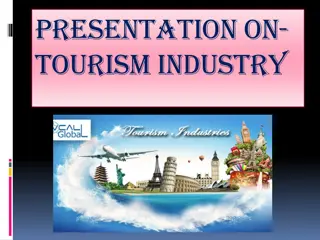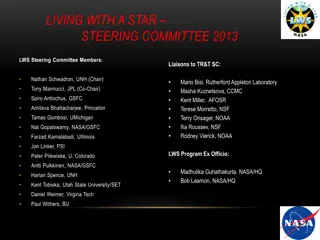Strategic Tourism Demand Forecasting Methods
The chapter delves into qualitative and quantitative approaches for tourism demand forecasting, including the Delphi method and executive opinion juries. It explores advanced forecasting methods and the application of big data analytics in the tourism industry. The focus is on generating expert opinions about the future to aid long-term forecasting, with an emphasis on maintaining anonymity and iterative polling of experts. The methodology and results of Delphi forecasting exercises are discussed, highlighting the importance of considering impacts far into the future, such as those projected for 2030.
Download Presentation

Please find below an Image/Link to download the presentation.
The content on the website is provided AS IS for your information and personal use only. It may not be sold, licensed, or shared on other websites without obtaining consent from the author.If you encounter any issues during the download, it is possible that the publisher has removed the file from their server.
You are allowed to download the files provided on this website for personal or commercial use, subject to the condition that they are used lawfully. All files are the property of their respective owners.
The content on the website is provided AS IS for your information and personal use only. It may not be sold, licensed, or shared on other websites without obtaining consent from the author.
E N D
Presentation Transcript
3rd Edition Strategic Management In Tourism Edited by LUIZ MOUTINHO AND ALFONSO VARGAS S NCHEZ
CHAPTER 4 TOURISM DEMAND MODELLING AND FORECASTING S.F. WITT, L. MOUTINHO, K.-H. HUARNG AND T.H.-K. YU
LEARNING OBJECTIVES To learn the qualitative approaches for modelling and forecasting. To learn the quantitative approaches for modelling and forecasting, including econometric and time series.
INTRODUCTION In everyday life, many things are highly predictable, but in other circumstances prediction is often difficult. There are two categories of tourism demand forecasting: qualitative and quantitative approaches. The qualitative approach includes judgemental forecasting and Delphi methods (Andrawis et al., 2011). Recently, big data analytics has become a hot research topic (Chen et al., 2012). The use of search index or composite index to assist forecast tourism becomes a new trend. The objective of this chapter is to examine several more advanced forecasting methods (qualitative and quantitative) and provide examples which illustrate potential applications of the various methods.
DELPHI FORECASTING/JURY OF EXECUTIVE OPINION The Delphi method of forecasting has attracted considerable attention in the tourism literature since the late 1970s (Robinson, 1979; Seeley et al., 1980; Kaynak and Macaulay, 1984; Var, 1984; Liu, 1988; Yong et al., 1989; Moeller and Shafer, 1994; Taylor and Judd, 1994). This technique aims to obtain expert opinion about the future through questionnaire surveys of a group of experts in the field, and is particularly useful for long-term forecasting. The distinguishing characteristics of Delphi forecasting are the aim to generate aggregate expert opinion about the future and the method used maintenance of strict anonymity within the group of experts and iterative polling of participants with feedback of group opinion between polls.
DELPHI FORECASTING/JURY OF EXECUTIVE OPINION continued The methodology was applied at the International Symposium on Tourism and the Next Decade which was held in Washington, DC during 1979, and was used to forecast international tourism conditions up to the year 2000. The particular consensus forecasting approach examined is jury of executive opinion.
DELPHI FORECASTING/JURY OF EXECUTIVE OPINION Results of a jury of executive opinion forecasting exercise carried out by S.F. Witt and L. Moutinho in 1992 are presented in which the distinguishing characteristics were: (i) That a specific time horizon far into the future (2030) was considered as opposed to the more usual year 2000 time horizon. (ii) That the emphasis was specifically upon the impacts of developments in science and technology upon tourism. (iii) That the forecast focus was not destination specific (e.g. Nova Scotia, Singapore). (iv) That the tourism experts were mainly European, but with some Central Americans also present, compared with the more usual non-destination specific forecasting situation in which the views of North American tourism experts predominate. Twenty-five possible future developments affecting tourism were selected from a framework developed by Shafer and Moeller (1988, 1994), in which they describe possible developments in science and technology that may strongly impact tourism planning and development.
Procedure The fieldwork was conducted in June 1992 in Valencia, Spain, at a tourism seminar, where 25 tourism experts were asked about their views on possible future developments in tourism. First, the objectives of the study were explained, and then the questionnaire was distributed. Next, the 25 possible future tourism developments were explained in detail, and participants were allowed to ask clarification questions. The tourism experts were then split into groups of five to discuss the various issues. A lunch break followed, during which the experts were encouraged to continue exchanging views. Then a final question clarification session took place before participants filled in the questionnaires individually.
Empirical results The mean scores of the responses by the group of tourism experts regarding the impact/importance of each development, its probability of occurrence and its most likely year of occurrence are presented in Table 4.1.
CROSS-IMPACT ANALYSIS The initial attempt is likely to generate a long list of alternatives which needs to be consolidated into a manageable size (e.g. 25 30 events) by means of group discussion, concentrated thinking, elimination of duplication, and refinement of the essence of the problem. The coordinator must have good observational, interpersonal, communication and interpretive skills in order to recognize and overcome threats to the discussion process. He or she should attempt to develop the following three stages in the group discussion: o Establish a rapport with the group, structure the rules of group interaction and set objectives. o Provoke intense discussion in the relevant areas. o Summarize the group s responses in order to determine the extent of agreement.
CROSS-IMPACT ANALYSIS continued The selected n events are represented in an n x n matrix for developing an estimated impact of each event on every other event. Case study example: The application of cross-impact analysis to a tourism example is now considered. The case is real, but artificial data are used to illustrate application of the technique. The evolution of tourist demand for the Azores is illustrated in Table 4.2. A complete breakdown is presented in Table 4.3. From 1988 there was a decline in the number of American and Canadian tourists (two of the more traditional markets for the Azores), and an increase in the number of tourists originating from less traditional European markets, such as Holland, Belgium and Spain. Geographically, the two direct competitors to the Azores are Madeira and the Canary Islands.
Table 4.3. Total shares of nights spent by foreign tourists (1990).
Situation analysis The Azores strengths and competitive advantages in the tourism sector, as perceived by Azores Tourist Board managers on the basis of market research studies, were described as follows: 1. High quality of life, absence of pollution and the provision of close contact with nature. Excellent location for deep-sea fishing, snorkelling and scuba diving. Good conditions for walking and hiking trips, as well as bird watching, and scientific tours to study the flora, vegetation and volcanic nature of the islands. Ideal stopover location for yachting and good facilities for golfers. Potential for the development of cultural and rural tourism. 2. 3. 4. 5.
Some of the major weaknesses which might hamper the development of tourism in the region were as follows: 1. Distance from the most important origin markets, cost of travel, and the reduced number of scheduled flights to the Azores. 2. Lack of superstructure, particularly in the area of entertainment: improvements here could increase tourists average spending levels and length of stay in the islands. 3. Inadequate professional qualification and training skills provided to staff employed in the tourism industry, which has a negative impact on the quality of tourist services offered to visitors. 4. Seasonality effects which create marked under-utilization of facilities during the low season and over-utilization during the high season. The tourism sector plays a crucial socioeconomic role in the development of the Azores in terms of its contribution to the gross domestic product, balance of payments, employment and payment of reasonable salaries.
Use of cross-impact analysis Being aware of the global trends in the tourism industry and tourist flows worldwide, and taking into consideration the internal situation of the Azores, tourism authorities considered which marketing strategies would be most effective in striking a balance between the role of tourism as a catalyst for sustainable socioeconomic development in the region and the preservation of the local cultural heritage, quality of life and the physical environment.
In addition to competition, the ATB was concerned with the analysis of four main environmental factors (events): Further decline in the number of tourist arrivals originating from the more traditional markets. Increased dependency on a limited number of airlines and specialized tour operators and travel agents. Increased cost of international travel. A general increase in domestic (internal) tourism. These events are arranged in matrix form as shown in Table 4.4. The arrows show the direction of the impacts.
Next, the impact should be quantified to show linkage strengths, i.e. to determine how strongly the occurrence of one event would influence the occurrence of each of the other events. To assist in quantifying the interactions, a subjective rating scale may be used (Table 4.5).
Table 4.6. The ATBs cross-impact matrix showing degrees of impact.
Another approach involves the use of probabilities of occurrence. Once the probability of occurrence of each event is assessed, then the change in that probability can be assessed for each interaction. The probabilities of occurrence can be entered in an information column preceding the matrix, and then the matrix may be constructed in the conventional manner. Table 4.7 illustrates the use of a cross-impact matrix incorporating interactive probabilities of occurrence and time relationships.
Table 4.7. The ATBs cross-impact matrix showing interactive probabilities of occurrence.
PROBABILITY FORECASTING It may not be necessary to obtain highly accurate forecasts of specific values, but only to ascertain whether the probability falls within a particular range of values, in order to support good tourism management decisions. Furthermore, it is usually assumed that there is a cost trade- off when choosing a forecasting model. This section examines the precision required for probability forecasts and the use of skew loss functions as applied to tourism. For a general discussion of probability forecasting, the reader is referred to Delugio (1998) and Makridakis et al. (1998).
Required accuracy levels Here we assess how accurate the forecasts of the probabilities associated with the occurrence of alternative states of nature need to be when we are considering problems involving few possible actions and few states of nature. The product is made by a batch process which, through equipment indivisibilities, is restricted to the following annual capacities: A1 1 million units A2 2 million units A3 3 million units The conditional opportunity losses under S1 (high sales) and S2 (low sales) are shown in Table 4.8.
Table 4.8. Conditional opportunity losses: new multi-unit tourist pack problem ( million).
Suppose that P(S1) denotes the probability that S1, occurs. Then P(S2) is equal to 1 P(S1). If P(S1) were equal to 0.1, then the expected opportunity losses (EOLs) of the three acts would be: EOL(A1) = 0.1(6) + 0.9(0) = 0.6 million EOL(A2) = 0.1(3) + 0.9(3) = 3.0 million EOL(A3) = 0.1(0) + 0.9(8) = 7.2 million Clearly, under these conditions act A1 (the low-capacity facility) would be preferable to the other courses of action. By assuming various values that P(S1) could take, we can construct the chart of expected opportunity losses. Skew loss functions: In more realistic cases a greater number of states of nature and courses of action are possible.
In either case, they would have considerably under- produced relative to the solution that takes into account the conditional costs of over- versus under-production. Although the need for accurate forecasts is often stressed, there are situations in which highly accurate point forecasts are not particularly useful. In particular, in the case of probability forecasting it is often necessary only to know whether or not the probability falls within a particular range of values. Even if increased accuracy can be obtained, it is often not the case that the additional cost entailed is justified.
ECONOMETRIC FORECASTING The econometric approach to forecasting tourism demand involves the use of regression analysis to estimate the quantitative relationship between tourism demand and its determinants; the estimation is carried out using historic data, and future values of tourism demand are obtained by using forecasts of the demand determinants in conjunction with the estimated relationship.
Tourism demand function The variables involved in tourism demand forecasting are discussed below. Forecast variable:Tourism demand is generally measured in terms of the number of tourist visits from an origin country to a foreign destination country, or in terms of tourist expenditures by visitors from the origin country in the destination country. Population: The level of foreign tourism from a given origin is expected to depend on the origin population. Income: In tourism demand functions, origin country income or private consumption is generally included as an explanatory variable, and commonly enters the demand function in per capita form (corresponding to the specification of demand in per capita terms). Own price: The appropriate form of the price variable is by no means clear. In the case of tourism there are two elements of price: the cost of travel to the destination; and the cost of living for the tourist in the destination.
Substitute prices: Economic theory suggests that the prices of substitutes may be important determinants of demand. Just as tourists living costs in substitute destinations are likely to influence the demand for tourism to a given destination, so travel costs to substitute destinations may also be expected to have an impact, and can be allowed for in a similar manner. Qualitative effects: Dummy variables can be included in international tourism demand functions to allow for the impact of one-off events. For example, when governments impose foreign currency restrictions on their residents (e.g. the 50 annual limit introduced in the UK during late 1966 to late 1969), this is expected to reduce outward tourism.
Trend: A trend mainly represents a steady change in the popularity of a destination country over the period considered, as a result of changing tastes. Marketing: National tourist organizations engage in sales-promotion activities specifically to attempt to persuade potential tourists to visit the country, and these activities may take various forms including media advertising and public relations. Lagged dependent variable: A lagged dependent variable, i.e. an autoregressive term, can be justified on the grounds of habit persistence. Once people have been on holiday to a particular country and liked it, they tend to return to that destination.
A second justification for the inclusion of a lagged dependent variable in tourism demand functions comes from the supply side. Supply constraints may take the form of shortages of hotel accommodation, passenger transportation capacity and trained staff, and these often cannot be increased rapidly. Empirical results: Examples of estimated econometric models are presented in Table 4.9. The most comprehensive study in terms of the variety of origins/destinations covered is by Martin and Witt (1988c), and the first ten models are taken from this study.
The forecasting performance of econometric models of international tourism demand is mixed. In the earlier studies econometric models often generated less accurate forecasts than simple extrapolative methods.
FUZZY TIME SERIES FORECASTING Fuzzy time series models refer to the procedures used to solve forecasting problems in which the historical data are linguistic values. The main difference between fuzzy time series and conventional time series is that the former consist of fuzzy sets while the latter are real numbers (Chen, 1996). People are used to conducting in-sample estimation as well as out-of- sample forecasting. In this case, the data are separated into in-sample and out-of-sample data, where the in-sample data are used for establishing the fuzzy relationships and out-of-sample data are for out-of-sample forecasting. Hereafter, we take the study of Huarng, Moutinho & Yu (2007) (hereafter, referred as neural network based model) as an example to illustrate the forecasting process of fuzzy time series model, where neural networks are used as the operation to train the fuzzy relationships and to forecast. Meanwhile, that study compares the performance of the proposed model with a conventional econometric model and a fuzzy time series model (Chen, 1996).
Data: The data are taken from Executive Information System, Tourism Bureau Ministry of Transportation and Communication, Taiwan (Republic of China). The monthly data are from 1984/01 to 2005/09, where those from 1984/01 to 2000/04 are used for neural network training and those from 2000/05 to 2005/09 are for forecasting. Taiwan tourist number at time t-1 is taken as the input and that at time t is taken as the output (the forecast target). Model: Step 1. Fuzzification Step 2. Neural Network Training Step 3. Forecasting Step 4. Defuzzification
Empirical results The root mean squared error (RMSE) is used to compare the performance of the neural network based model with others, as in Table 4.10.
Table 4.10. The comparison of performance among different models. a RMSE, root mean squared error.
CONCLUSION Forecasts of tourism demand are crucial for planning purposes. In this chapter, a range of tourism forecasting methods has been outlined which can be applied in a wide variety of situations.



